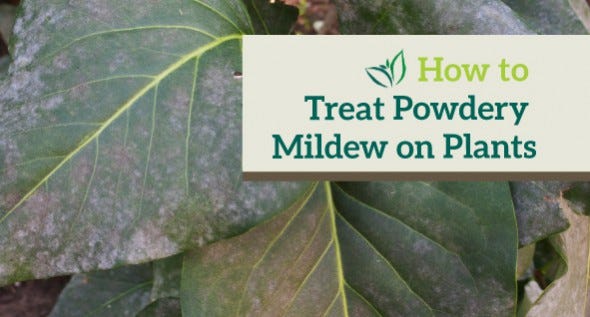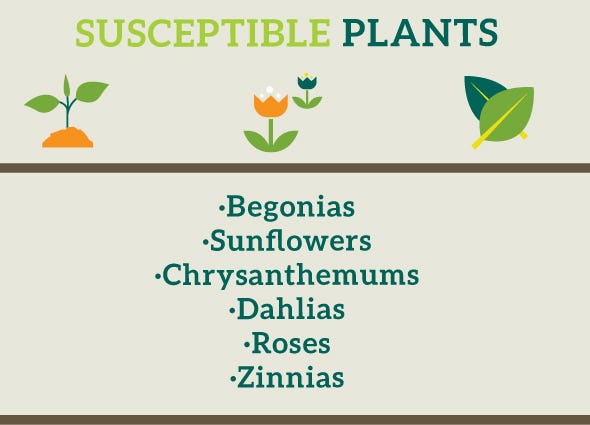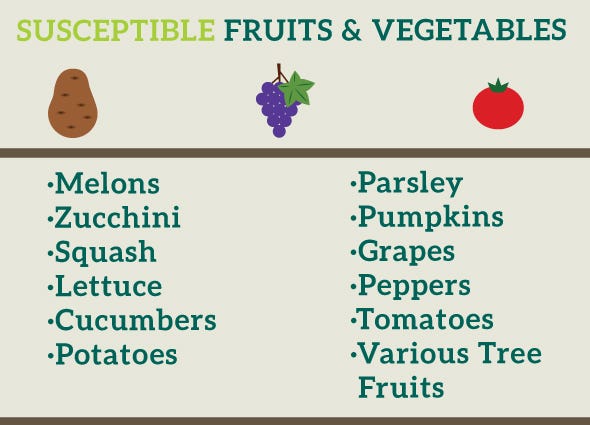How to Get Rid of White Spots on Plants
Though the weather across much of the country may indicate otherwise, spring is on the horizon. That means it's time to at least start thinking about what to plant in your garden this year and which types of diseases your plants may be susceptible to. Powdery mildew is a relatively common fungus that many plants can contract. If you find powdery mildew on your plants, it's not necessarily fatal, but you don't want it hanging around. Fortunately, there are many options for powdery mildew treatment.
What Is Powdery Mildew?
Powdery mildew thrives in conditions opposite those where you would find ordinary mildew. Instead of liking wet and damp conditions, powdery mildew actually prefers warm and dry environments. When it shows up, it's often first thought to be dust or dirt and can be swept away with your finger – then it returns. It appears as light white or gray spots on the tops and bottoms of the leaves, stems, new growth, flowers and even fruit or vegetables.

What Causes Powdery Mildew on Plants?
Powdery mildew forms when plant foliage is dry, lighting is low, temperatures are moderate and there is high humidity. Ideal conditions for powdery mildew growth is often during the late spring or early summer when evenings are still cool and somewhat humid, but the days are beginning to get warm.
Is Powdery Mildew Dangerous?
In many cases, powdery mildew is not fatal to the plant; instead, it's more of an aesthetic issue. However, if left untreated, powdery mildew can leech nutrients from the plant, eventually causing leaves to wither and yellow. This can make blooms unsightly and leave vegetables and fruits particularly vulnerable to sunburn. Powdery mildew can eventually reduce the plant's producing capacity and affect the flavors of fruits and vegetables.
Which Plants and Vegetables Are Most Susceptible?
There is a variety of powdery mildew species and they can affect different types of plants. While no plant is 100% immune,here are someplants that tend to be particularly susceptible.

Here are some fruits and vegetables where you would be most likely to find powdery mildew.

Note that this is not an all-inclusive list, so always keep a vigilant eye on your plants for signs of powdery mildew development.
Can Powdery Mildew Spread to Other Plants?
Powdery mildew spores are spread by the wind and can survive the winter in debris piles or on plants. The good news is that just because you find it on one plant, it doesn't mean all others nearby will be contaminated. If you catch powdery mildew on zucchinis, roses or other plants, employ preventative measures, like the ones listed below, to ensure your other plants are not in conditions favorable to its development.
How Can I Prevent Powdery Mildew?
One way to prevent powdery mildew is to plant mildew-resistant plant varieties. If that isn't an option, though, here are some other steps to take:
- Ensure there is enough spacing between your plants to provide enough airflow around all parts of the plant.
- Don't over fertilize your plants. New growth tends to be very susceptible to powdery mildew development.
- Put plants where they will get enough light and avoid overly shady locations.
- Make sure the soil can drain properly. Inadequate drainage can make soil a breeding ground for disease-causing organisms.
- Use compost to boost the nutrient levels in the soil, which will in turn increase beneficial microorganism populations.
- Keep plants properly maintained by removing any dead or diseased foliage and stems.
- Use preventative treatment options, like a sulfur fungicide, before powdery mildew even forms.
How to Treat Powdery Mildew
If your plants do develop powdery mildew despite your best efforts, don't worry. There are many environmentally friendly options for eliminating the disease, including:
 Baking Soda. Baking soda itself isn't normally effective as a powdery mildew treatment, but when it's combined with liquid soap and water, it can be a powerful weapon. It's normally most beneficial if used as a preventative measure rather than a treatment. Combine one tablespoon baking soda and one-half teaspoon of liquid, non-detergent soap with one gallon of water, and spray the mixture liberally on the plants.
Baking Soda. Baking soda itself isn't normally effective as a powdery mildew treatment, but when it's combined with liquid soap and water, it can be a powerful weapon. It's normally most beneficial if used as a preventative measure rather than a treatment. Combine one tablespoon baking soda and one-half teaspoon of liquid, non-detergent soap with one gallon of water, and spray the mixture liberally on the plants.
 Mouthwash. The mouthwash you may use on a daily basis for killing the germs in your mouth can also be effective at killing powdery mildew spores. Since its function is to kill germs, the powdery mildew spores can't withstand it. Using three parts water to one part mouthwash has been found to be a good ratio, but new growth can be damaged since mouthwash is potent, so use with caution.
Mouthwash. The mouthwash you may use on a daily basis for killing the germs in your mouth can also be effective at killing powdery mildew spores. Since its function is to kill germs, the powdery mildew spores can't withstand it. Using three parts water to one part mouthwash has been found to be a good ratio, but new growth can be damaged since mouthwash is potent, so use with caution.
 Milk. Milk is making its way onto the scene as a viable means to control powdery mildew. Not all the science is known, but the compounds in milk may be able to act as an antiseptic and fungicide as well as potentially increase the plant's overall immunity. It tends to be effective as a method of preventing powdery mildew on zucchini and other types of squash, as well as cucumbers. An effective mixture ratio is about one part milk to two or three parts water.
Milk. Milk is making its way onto the scene as a viable means to control powdery mildew. Not all the science is known, but the compounds in milk may be able to act as an antiseptic and fungicide as well as potentially increase the plant's overall immunity. It tends to be effective as a method of preventing powdery mildew on zucchini and other types of squash, as well as cucumbers. An effective mixture ratio is about one part milk to two or three parts water.
 Organic Fungicide Treatments. If you don't want a do-it-yourself solution, there is a variety of commercial treatment options that are just as environmentally friendly and approved for organic gardening. By going this route, you also know exactly what types of pests the treatment will kill and which types of plants it's most helpful for.
Organic Fungicide Treatments. If you don't want a do-it-yourself solution, there is a variety of commercial treatment options that are just as environmentally friendly and approved for organic gardening. By going this route, you also know exactly what types of pests the treatment will kill and which types of plants it's most helpful for.
 Water. Since dry conditions coupled with high humidity are often the culprits behind powdery mildew growth, watering your plants overhead and getting the entire plant wet can help. However, it's important to use this method somewhat sparingly as overwatering can cause other issues for your plants.
Water. Since dry conditions coupled with high humidity are often the culprits behind powdery mildew growth, watering your plants overhead and getting the entire plant wet can help. However, it's important to use this method somewhat sparingly as overwatering can cause other issues for your plants.
Why Choose Safer® Brand?
Sometimes with a do-it-yourself option, it can be difficult to ensure the ratios of ingredients are correct, and if they aren't just so, the treatment may not work how you were anticipating. You may also need to use caution on which parts of the plants you apply homemade remedies. When trusting your plant's health to the experts at Safer® Brand, you know for sure what you're getting in each bottle and that it's safe and effective for all parts of the plant.
Safer® Brand's powdery mildew treatments are OMRI certified, which means it's approved for use in organic gardening. It works by utilizing the power of sulfur compounds, which ultimately alter the plant's pH. It's not harmful to the plant, but powdery mildew and other fungi cannot survive.
Shop Safer Brand® OMRI Listed® Products »
Another benefit of using a fungicide that's formulated for organic gardening like those Safer® Brand offers is that it doesn't harm the soil. Millions of tiny microbes reside in the soil, providing your plant with nutrients and protecting it from pathogens. Using organic disease-control methods can help keep beneficial microorganism populations where they should be and your soil and plants healthy.
So, whether it's powdery mildew on squash or powdery mildew on roses, Safer® Brand's line of organic gardening treatments can help your plants, and the environment, stay disease-free and beautiful.
How to Get Rid of White Spots on Plants
Source: https://www.saferbrand.com/articles/treat-powdery-mildew-plants
